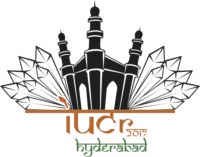Day 6, Saturday 26 August:Imaging Protein Dynamics
Dr Clare Sansom, Department of Biological Sciences, Birkbeck College, London, UK
 One of the most exciting developments in macromolecular crystallography in the last decade – and one that is already proving game-changing for the discipline – is the use of exceptionally fast and intense pulses of X-rays generated by free-electron lasers to image proteins in motion. Free-electron laser facilities are more complex and expensive to build even than synchrotrons, and only a handful have come on line so far. John Spence of the Physics department at Arizona State University, who gave the second plenary lecture at IUCr 2017, is the director of one of these: the NSF-funded BioXFEL, which is physically located in Buffalo, New York.
One of the most exciting developments in macromolecular crystallography in the last decade – and one that is already proving game-changing for the discipline – is the use of exceptionally fast and intense pulses of X-rays generated by free-electron lasers to image proteins in motion. Free-electron laser facilities are more complex and expensive to build even than synchrotrons, and only a handful have come on line so far. John Spence of the Physics department at Arizona State University, who gave the second plenary lecture at IUCr 2017, is the director of one of these: the NSF-funded BioXFEL, which is physically located in Buffalo, New York.
Spence studied for his Ph.D. in Melbourne, Australia and spent a few years as a postdoc in the University of Oxford, UK before moving to Arizona in 1976. During over four decades there he has accumulated honours, including foreign membership of the Australian Academy of Science and the UK’s Royal Society. He spent many productive years working in protein electron microscopy before switching, fairly late in his career, to the emerging field of free electron laser crystallography.
He began his talk by quoting the great US physicist, Richard Feynman, as saying that “every living thing can be understood by the wiggling and jiggling of atoms”. He remembered having been told as a student in the early 1970s that it would never be possible to visualise atoms in motion; now, thanks to free-electron lasers (which were invented in 1971, but not used in crystallography for over thirty years) this has become a cornerstone of his research. He paid a generous tribute to Henry Chapman, who leads the free electron laser facility at DESY in Hamburg, Germany, whose “drive, ambition and deep understanding of diffraction physics” have played an important part in establishing the technique in structural biology.
Free-electron lasers work by wiggling fast-moving electrons sideways as they pass through a magnetic field. This generates tiny pulses of X-ray photons that last no more than a few femtoseconds (1fs = 10-15s) and that can be used instead of lower-intensity X-ray beams in protein crystallography. This offers numerous advantages: the pulses are so fast that they cause little damage to protein crystals, despite their intensity; they can take consecutive ‘snapshots’ of proteins moving at room temperature in near real time; and they can generate structures successfully from crystals that are too small for conventional X-ray crystallography.
Spence spent much of the rest of his talk describing examples of protein structures that have been studied using this approach and where new insights have been generated. It is now possible to take ‘snapshots’ of proteins in motion only about 150 fs apart, which is fast enough to resolve the process of photon absorption by retinal bound to rhodopsin in the human eye. It is therefore possible to observe the stages in the cis-trans isomerisation from 11-cis-retinal to the all-trans isomer, which leads to a conformational change in rhodopsin that activates its bound G-protein.
Light sensitive reactions are some of the easiest to observe using this technique, but only a small fraction of proteins are in fact light sensitive. Spence described how it can also be used to look at reactions that are triggered by mixing, such as enzyme catalysis. Here the components to be mixed are placed in capillary tubes one inside each other; the protein is micro-crystalline and the reaction is triggered once the components are combined and the ligand has diffused into the micro-crystals. He explained how his group produces prototypes of the nanoscale components necessary for this technology using a 3D printer before describing two examples – visualisations of the mechanisms of gene expression regulation with riboswitches, and beta-lactamase binding to penicillin antibiotics – in some detail. The beta-lactamase example is particularly important because this enzyme is one of the commonest causes of antimicrobial resistance.
In the final part of his talk, Spence discussed some recent developments and other novel ideas that are still on the drawing board. It is now possible to study the structures of membrane proteins with laser-generated X-ray beams by delivering nanocrystals of the proteins using a tube of viscous material, memorably described as both a ‘grease gun’ and a ‘toothpaste jet’. This – and the visualisation of intact virus particles – is still tricky and time-consuming; in contrast, nanocrystals of soluble proteins are becoming tractable enough that it is possible to ‘shoot first, ask questions afterwards’. The minimum X-ray pulse size is becoming even shorter, with a few machines generating pulses only a few tens of attoseconds (1as = 10-18s) long. He described briefly some of the experiments that will become possible once this type of laser is in routine use for crystallography. And, having started with a quote from Feynmann, he ended with one from a scientist who flourished some 150 years earlier. As Sir Humphrey Davy, the inventor of electrochemistry, wrote in 1806 (in paraphrase): “Nothing promotes the advancement of science so much as a new instrument”.